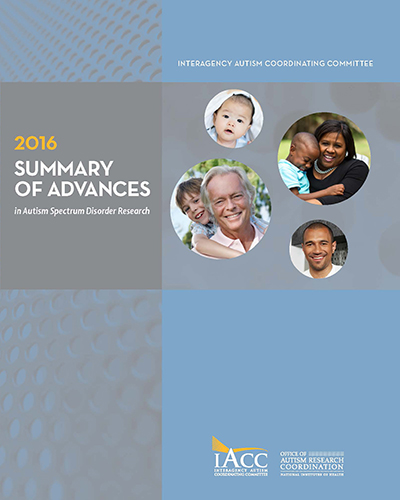Summary of Advances
In Autism Spectrum Disorder Research
2016
Articles Selected for the 2016 Summary of Advances
1) Reduced engagement with social stimuli in 6-month-old infants with later autism spectrum disorder: a longitudinal prospective study of infants at high familial risk. 2) School-age outcomes of infants at risk for autism spectrum disorder. 3) Peripheral mechanosensory neuron dysfunction underlies tactile and behavioral deficits in mouse models of ASDs. All articles.
Question 1: When Should I Be Concerned?
Reduced engagement with social stimuli in 6-month-old infants with later autism spectrum disorder: a longitudinal prospective study of infants at high familial risk: The average age of an ASD diagnosis in the U.S. is approximately 4 years old. Research has shown that up to 20% of infants who have an older sibling with ASD will also be diagnosed with ASD later in their lives. Parents may suspect ASD prior to a formal diagnosis, particularly if their infant has a sibling with an ASD diagnosis. Read more.
Question 2: How Can I Understand What Is Happening?
Peripheral mechanosensory neuron dysfunction underlies tactile and behavioral deficits in mouse models of ASDs: Unusual or increased sensitivity to touch is a common symptom in individuals with ASD. The experience of touch in early childhood is important for the development of social behaviors and communication, and it is possible that hypersensitivity to touch can contribute to social and communication challenges later in a child’s life. Read more.
Question 3: What Caused This to Happen and Can It Be Prevented?
Effect of co-twin gender on neurodevelopmental symptoms: a twin register study: There is a higher prevalence of ASD and attention-deficit/hyperactivity disorder (ADHD) in males than females. There is evidence of significant heritability in both ASD and ADHD, but there are also thought to be significant environmental factors involved in risk of diagnosis. For instance, past research suggests that exposure to high levels of testosterone in the womb may increase the risk for development of ASD and ADHD. Read more.
Question 4: Which Treatments and Interventions Will Help?
Longitudinal effects of adaptive interventions with a speech-generating device in minimally verbal children with ASD: Studies estimate that 25-30% of children with ASD who engage in communication interventions will not achieve spoken communication. Failure to develop spoken language by school-age increases the likelihood of poor longterm outcomes in social functioning. Timing of effective communication intervention is also critical, as there is a developmental window for children to develop communication skills. Read more.
Question 5: Where Can I Turn for Services?
The effects of Medicaid home and community-based services waivers on unmet needs among children with autism spectrum disorder: Health services for children with ASD can be a significant financial burden on families. Until recently, most ASD intervention and treatment programs were not included in insurance benefits, making it more difficult for children with ASD to access the care they need. To address this service gap, many states provide Medicaid Home and Community-Based Services (HCBS) waivers to expand health service coverage and eligibility for children with ASD. Read more.
Question 6: What Does the Future Hold, Particularly for Adults?
Premature mortality in autism spectrum disorder: Past research suggests that individuals with ASD have a higher risk of premature mortality, but the specific factors that impact this risk are unclear. Individuals with ASD often have co-occurring medical conditions, such as seizures and intellectual disabilities, which may be associated with increased risk of premature mortality. Further, previous studies have found that females with ASD have a higher risk of mortality than males with ASD. Read more.
Question 7: What Other Infrastructure and Surveillance Needs Must Be Met?
Prevalence and characteristics of autism spectrum disorder among children aged 8 years—Autism and Developmental Disabilities Monitoring Network, 11 sites, United States, 2012: Ongoing efforts to monitor the prevalence of ASD are important to substantiate the need for service and treatment programs, identify vulnerable populations, justify increased funding, and support new policies. The Autism and Developmental Disabilities Monitoring (ADDM) Network is a group of programs funded by the Centers for Disease Control and Prevention (CDC) to monitor the prevalence and characteristics of ASD in 8-year-old children (the age by which most children have been diagnosed). Read more.




